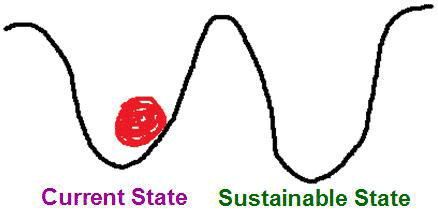47 Transitioning to Sustainability
On this page, we conclude our unit on sustainable development by discussing the process of transitioning from less sustainable to more sustainable development.
In the sustainable development modules, we (the course designers) have attempted to show that sustainable development can also be enjoyable development. To see this, recall the end uses of sustainable development. Foods that have lower environmental impacts are often also healthier and tastier. High-density, mixed-use urban developments often have vibrant culture and aesthetic beauty. Non-motorized transport (walking, biking, etc.) also gets us exercise, making us healthier and happier. We see this time and time again: sustainable development is pleasant development. It would seem to be a win-win situation: people today get to live nice lives, and the environment and future generations benefit in the process. This observation is in stark contrast with the idea that protecting the environment requires arduous sacrifices. Perhaps sustainable development is not that much of a collective action problem after all.
If sustainable development is such a good idea, then why don’t we see more of it? There are many reasons for this, but one idea is at the center: the challenge of transition. Regardless of how nice sustainable development might be when we get there, the process of transitioning there from where we are now is difficult. Because the transition is so difficult, we don’t do it as much as we could or perhaps should. The difficulty of the transition can be expressed in terms of the idea of system resilience from Module 2.

The difficulty of the transition has two main parts. One involves physical infrastructure. Our farms, buildings, and roads are largely set up for an unsustainable type of development. Transitioning to sustainable development would require rebuilding a lot of this. That’s a lot of work! Even if more sustainable infrastructure ends up being eventually more pleasant or less expensive to operate, it is often more expensive over the short-term. Indeed, discussions of sustainable development often highlight the concept of the break-even point, which is the point in time in the future in which an investment in more sustainable physical infrastructure breaks even. Before the break-even point, the investment loses money (or whatever else is being counted). After the break-even point, the investment makes money/etc. For example, we might spend more money constructing a more energy-efficient building, but over the course of the building’s lifetime, we save money on energy costs.
The other part of the difficulty of the transition is cognitive. Simply put, our minds require some transition, too. Part of the cognitive transition involves learning some new things. If we’re going to eat foods with lower environmental impacts, then we need to learn to use some new recipes or restaurants. If we’re going to use different transportation modes, then we need to learn how to use those. But part of the cognitive transition goes beyond learning. This involves habits and social norms. We might know full well how to cook a meal or get around town in a more sustainable manner, but we still find ourselves in the habit of doing the same things we always have been doing. Changing habits can be a very difficult thing to do. Or, we might be able to change our habits, but find ourselves in social circumstances in which the new habits are not considered normal. Maybe your friends are all going out for hamburgers or buffalo wings and would tease you if we ordered a vegetarian option. Maybe your family doesn’t want to move to an area where you and they could walk everywhere. In scenarios like this, it’s entirely possible that the other people in your social group would be more positive and accommodating after they went through a cognitive transition of their own. Either way, it remains the case that social norms can make transitions to sustainability – or to anything else, for that matter – more difficult. The same can be said for the other aspects of cognitive transition: learning and habits.
The challenge of transition makes achieving sustainable development quite a lot more difficult. But the challenge also opens up opportunities. Today, many people are employed in various aspects of sustainable development largely to facilitate the transition. Whether you’re in engineering or advertising, farming or law, or virtually any other profession, there are opportunities to help with the transition to sustainable development. Succeeding with this involves understanding the interconnections between your profession and sustainability.
And with that, our sustainable development unit comes to an end.
Our third and final unit, global environmental change, explains why the transition to sustainability is so important. In short, the fate of the global human-environment system is at stake, including our very survival. So, while sustainable development can be pleasant, and the transition can be difficult, the transition is also quite important. Arguably, nothing at all is more important.

